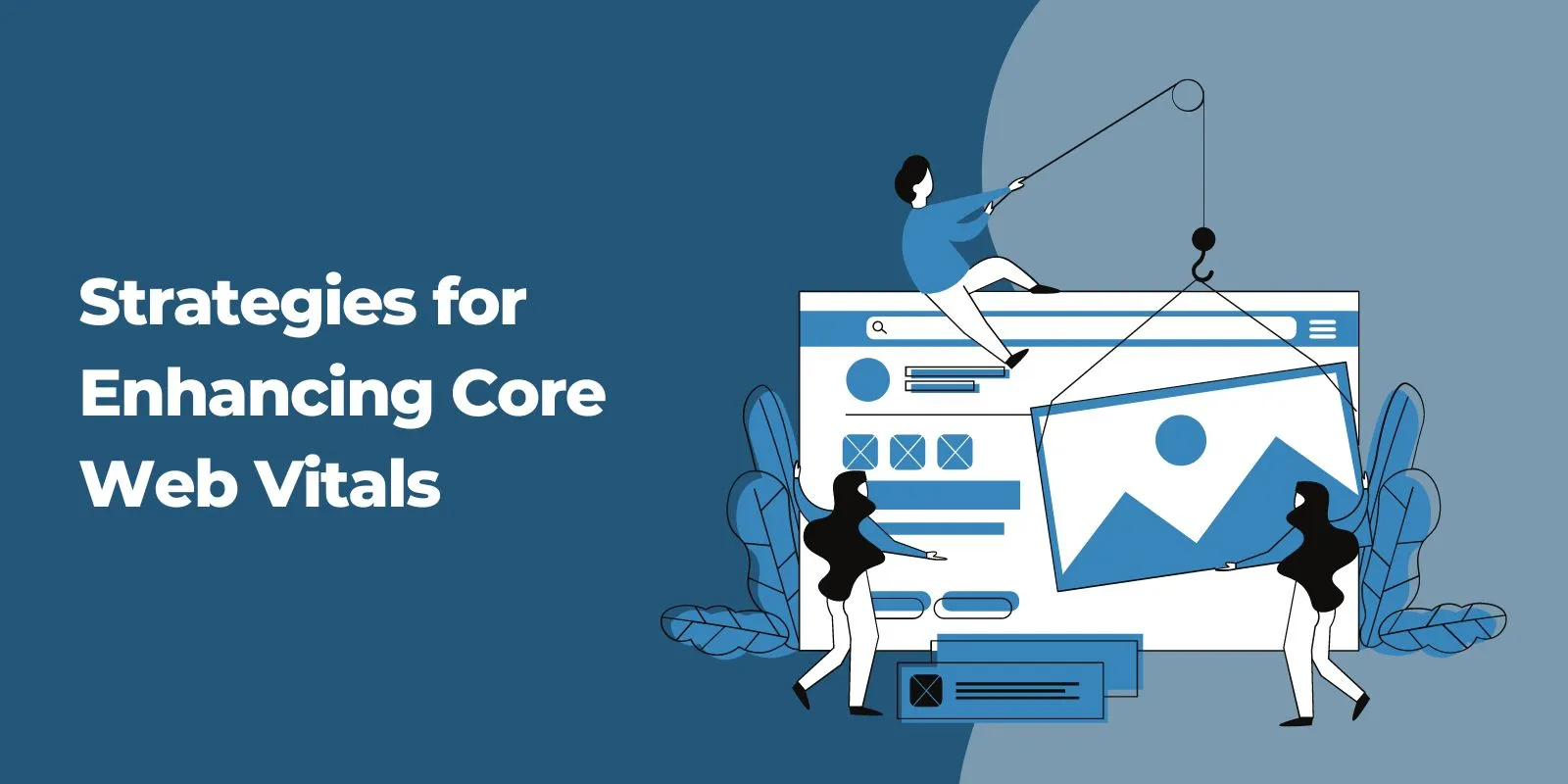Search engines like Google prioritize websites that deliver fast and smooth experiences, making it essential to optimize these vital metrics.
Dive into the world of Core Web Vitals and learn how they impact your website’s performance, user experience, and search engine rankings. Let’s unlock the secrets to enhancing your website and driving more traffic, conversions, and customer engagement.
The Fundamentals of Core Web Vitals
Core Web Vitals are a set of metrics introduced by Google that measure the user experience of website pages, focusing on page loading, interactivity, and visual stability.
These metrics have gained significant importance in the SEO landscape, as they are an officially recognized Google Search ranking factor.
By understanding and optimizing Core Web Vitals, site owners can improve search rankings, enhance user experience, and ultimately increase conversions and leads for their business.
The Three Key Metrics
At the heart of Core Web Vitals are three primary metrics: Largest Contentful Paint (LCP), First Input Delay (FID), and Cumulative Layout Shift (CLS). LCP measures the time taken for the largest element on a web page to begin loading, reflecting the loading performance of the primary content on a webpage.
FID, on the other hand, gauges the interactivity and responsiveness of a website by measuring the time between a user’s first interaction with the page and when the browser responds to the input.
The third metric, CLS, assesses the visual stability of a web page, detecting any layout shifts that can adversely affect user experience. These shifts are commonly caused by ads, images, and other page layout elements that load after the user has already begun interacting with the content.
By optimizing these three key metrics, site owners can ensure a smooth and enjoyable browsing experience for their users.
Real User Data and Its Importance
Core Web Vitals stand out from other performance metrics due to their focus on actual user experiences rather than synthetic benchmarks.
The Chrome User Experience Report (CrUX) is a report that contains data from Chrome users who have opted to share their information. Data for Core Web Vitals is sourced from this report.
This real-world data is essential for a critical user-centric outcome, ensuring that the metrics are an accurate representation of the user experience.
The geographic location of website visitors can also affect Core Web Vitals, as the distance between the user and the server or content delivery network (CDN) can impact loading times.
By prioritizing real user data, Core Web Vitals provide a more accurate and actionable picture of website performance, allowing site owners to identify areas for improvement and optimize their website for better user experience and search engine rankings.
How Core Web Vitals Impact SEO Performance
Core Web Vitals play a crucial role in determining a website’s search engine rankings, as they assess the overall user experience of website pages. Sites with “Good” Core Web Vitals scores may receive higher search rankings than those with “Poor” scores.
By optimizing these metrics, website owners can improve their organic rankings, attract more traffic, and ultimately boost their conversion rates and customer engagement.
User Experience and Organic Rankings
User experience is a critical factor in SEO, as search engines like Google prioritize websites that provide a satisfactory user experience.
Optimizing a website for improved user experience can lead to better organic search rankings, as search engines assess user behavior data, such as site speed, security, mobile-friendliness, quality content, and user engagement metrics, to determine a website’s ranking.
An enhanced user experience not only keeps visitors on your website longer, but also increases the likelihood of them taking the desired action, such as making a purchase or signing up for a newsletter.
As a result, an optimized website with a focus on Core Web Vitals can significantly improve its organic rankings and drive more traffic, conversions, and customer engagement.
Conversion Rates and Customer Engagement
The relationship between Core Web Vitals, conversion rates, and customer engagement is profound. A website that loads quickly and is user-friendly is more likely to retain visitors and encourage them to interact with the content, leading to increased conversions and customer engagement.
By focusing on optimizing Core Web Vitals, businesses can enhance their website’s performance and user experience, ultimately leading to increased customer engagement, higher conversion rates, and better overall business performance.

Award-Winning
Sales Funnel & Website Expert
Ready for Revenue – Not Just “Traffic”?
- Websites that Work: Clean, fast, built to convert – no design fluff.
- Funnels that Sell for You: Step-by-step paths that turn clicks into paying customers.
- SEO That Hunts Buyers: Show up exactly when prospects reach for their wallets.
It is evident that investing time and resources in understanding and improving Core Web Vitals can significantly impact a website’s success and profitability.
Tools and Techniques for Measuring Core Web Vitals
To effectively assess and improve Core Web Vitals performance, various tools and methods are available. These include Google’s suite of tools such as Google Search Console, PageSpeed Insights, and Lighthouse, as well as third-party solutions that provide additional insights and optimization suggestions.
By leveraging these tools and techniques, website owners can gain a comprehensive understanding of their website’s Core Web Vitals performance and implement necessary improvements.
Google’s Suite of Tools
Google offers an array of tools for monitoring and optimizing Core Web Vitals, such as Google Search Console and Lighthouse.
Search Console provides Core Web Vitals reports for both desktop and mobile versions of your site’s pages, categorizing them as Good, Needs Improvement, or Poor for any of the Core Web Vital metrics.
This valuable information can help website owners identify areas for improvement and prioritize optimization efforts.
Another powerful tool in Google’s suite is PageSpeed Insights, which gathers page-level data, origin data, and lab test data from Lighthouse.
Lighthouse is an open-source tool that audits the performance, accessibility, and SEO of web pages, providing detailed reports and recommendations for improvement.
By utilizing these Google tools, website owners can effectively measure their Core Web Vitals performance and implement the necessary optimizations to enhance user experience and search engine rankings.
Third-Party Solutions
Apart from Google’s suite of tools, there are several third-party solutions available for measuring and optimizing Core Web Vitals. Popular tools include Sematext, WebPageTest, and the Web Vitals extension for Google Chrome.
These tools offer additional insights and perspectives on your website’s performance, allowing you to identify and resolve issues that may not be apparent through Google’s tools alone.
For those using WordPress, various plugins such as WP Rocket, NitroPack, and Asset Clean Up can assist in optimizing Core Web Vitals performance.
By leveraging these third-party solutions, website owners can effectively measure and optimize their Core Web Vitals, ensuring a smooth and enjoyable user experience that ultimately leads to better search engine rankings and increased conversions.
Strategies for Enhancing Core Web Vitals
Improving Core Web Vitals scores requires a strategic approach, focusing on optimizing key aspects of your website’s performance. In this section, we’ll provide actionable tips and best practices for enhancing Core Web Vitals scores across the three key metrics: LCP, FID, and CLS.
By implementing these strategies, website owners can significantly improve their website’s user experience, organic search rankings, and overall performance.
Optimizing LCP
Reducing the loading time of the largest content element on a web page is crucial for optimizing LCP. Some steps to improve LCP include optimizing images and videos, reducing server response times, and minimizing render-blocking resources.
These optimizations not only improve LCP, but also contribute to an overall faster-loading website.
Grouping pages with similar templates can also be beneficial, as it allows for changes to be implemented in the template, which will be reflected across all pages in the group.
By focusing on optimizing LCP, website owners can significantly enhance the loading performance of their web pages, leading to a better user experience and improved search engine rankings.
Reducing CLS
Minimizing layout shifts and improving visual stability is essential for optimizing CLS. Some potential causes of layout shift include dynamic content insertion above existing content, images, and fonts.
Google provides several suggestions for reducing CLS, such as minimizing the use of pop-ups and banners, allocating space for ads and other dynamic content, and employing CSS animations instead of JavaScript.
By implementing these strategies, website owners can effectively reduce CLS and improve the visual stability of their web pages. This, in turn, leads to a more enjoyable user experience, increased customer engagement, and higher search engine rankings.
Improving FID
Enhancing interactivity and responsiveness is key to optimizing FID. Some suggested strategies for improving FID include optimizing CSS and JavaScript code, breaking up long JavaScript tasks, delaying or removing non-critical third-party scripts, and utilizing web workers. An FID score of 100 milliseconds or less is considered optimal by Google.
By focusing on these strategies, website owners can improve their website’s FID score and enhance the overall interactivity and responsiveness of their web pages.
As a result, users will enjoy a smoother browsing experience, leading to increased customer engagement, better search engine rankings, and higher conversion rates.
Challenges and Potential Pitfalls in Core Web Vitals Optimization
Optimizing Core Web Vitals is not without its challenges and potential pitfalls, as website owners need to balance performance and functionality while staying up-to-date with evolving metrics and SEO best practices.
In this section, we will address some common obstacles and mistakes when working with Core Web Vitals, providing valuable insights to help you avoid these issues and achieve better SEO performance.
Balancing Performance and Functionality
Striking the right balance between website speed and features is a critical aspect of optimizing Core Web Vitals.
The more features a website has, the slower it will tend to be, as additional code is required to support the features, affecting loading time.
To maintain a balance between performance and functionality, website owners can implement strategies such as optimizing images, minifying code, caching, and leveraging a content delivery network (CDN).
By focusing on these optimization strategies while staying mindful of the trade-offs between website speed and features, website owners can create user experiences that satisfy while also ensuring that the website functions effectively and loads quickly.
Staying Up-to-Date with Evolving Metrics
Keeping up with changes in Core Web Vitals and SEO best practices is essential for ensuring that a website remains optimized and competitive in search engine rankings.
To stay informed about evolving metrics and best practices, website owners can regularly monitor their website’s performance, subscribe to industry newsletters, follow industry blogs, and attend webinars and conferences.
By remaining informed and actively participating in the SEO community, website owners can adapt to changes in Core Web Vitals and SEO best practices, ensuring that their website remains optimized and competitive in search engine rankings.
This proactive approach can lead to higher organic traffic, increased customer engagement, and improved overall business performance.
Case Studies: Core Web Vitals Success Stories
To truly understand the impact of Core Web Vitals optimization on SEO performance, it’s essential to look at real-world examples. Numerous businesses have successfully improved their SEO performance through Core Web Vitals optimization, showcasing the power of these metrics in driving website success.
One such example is an e-commerce website that implemented several Core Web Vitals optimizations, including image compression, lazy loading, and code minification.
These changes led to significant improvements in their LCP, FID, and CLS scores, resulting in an increase in organic traffic, higher conversion rates, and overall better user experience.
Another case study involves a news website that focused on optimizing their CLS by allocating space for ads and dynamic content, minimizing the use of pop-ups and banners, and employing CSS animations.
These optimizations led to a dramatic decrease in layout shifts, providing a more stable and enjoyable user experience for their readers. As a result, the website experienced a boost in organic search rankings, increased user engagement, and higher ad revenue.
Frequently Asked Questions
What are the Core Web Vitals?
Core Web Vitals are a set of specific factors that Google considers important in a webpage’s overall user experience. They are part of Google’s page experience signals, which measure how users perceive the experience of interacting with a web page.
Core Web Vitals consist of three specific user interaction and page speed metrics: Largest Contentful Paint (LCP), First Input Delay (FID), and Cumulative Layout Shift (CLS). These metrics are designed to help site owners measure user experience on the web in terms of loading performance, interactivity, and visual stability.
What are the 3 pillars of Core Web Vitals?
The three pillars of Core Web Vitals are:
- Largest Contentful Paint (LCP): This metric measures the loading performance of a web page. Specifically, it quantifies the time it takes for the largest content element in the viewport to become fully visible after the user initiates the page load. A good LCP score is considered to be 2.5 seconds or less.
- First Input Delay (FID): This metric measures the interactivity and responsiveness of a web page. It captures the time from when a user first interacts with your page (such as clicking a link or tapping a button) to the time the browser is actually able to respond to that interaction. A good FID score is considered to be 100 milliseconds or less.
- Cumulative Layout Shift (CLS): This metric measures visual stability. It quantifies the amount of unexpected layout shift of visible page content. A low CLS score (less than 0.1) indicates a page that provides a stable visual experience for users.
What is the Core Web Vital score test?
The Core Web Vitals score test is an evaluation of a webpage’s performance based on the three Core Web Vitals metrics: LCP, FID, and CLS. These scores can be measured using a variety of tools such as Google’s PageSpeed Insights, Google Search Console, or Chrome User Experience Report.
These tools provide insights into a webpage’s performance and offer suggestions for improvement. A good Core Web Vitals score indicates a page that is fast, responsive, and visually stable, thereby offering a great user experience.
What is the importance of Core Web Vitals?
Core Web Vitals are important because they directly impact the user experience on a website. Pages that perform well on Core Web Vitals provide a better user experience, leading to higher user engagement, better conversion rates, and overall user satisfaction.
Furthermore, Google has incorporated Core Web Vitals into its ranking algorithm, which means that they also play a crucial role in search engine optimization (SEO). Websites that meet the Core Web Vitals thresholds will likely be favored in Google’s search results, which can lead to more traffic and visibility for your site.
Is Core Web Vitals a ranking factor?
Yes, as of June 2021, Core Web Vitals are a ranking factor in Google’s search algorithm. Google uses Core Web Vitals along with other page experience signals to assess the overall user experience provided by a webpage.
This means that the performance of a webpage in terms of LCP, FID, and CLS can influence its rankings in Google’s search results. However, while Core Web Vitals are important, Google has indicated that they are one of many factors used to rank pages and that high-quality, relevant content will always be crucial.
Does failing Core Web Vitals affect SEO?
Failing Core Web Vitals can indeed affect a webpage’s search engine optimization (SEO). Since Google has incorporated Core Web Vitals as part of its ranking factors, poor performance on these metrics could potentially lead to lower rankings in search results.
What are the Core Web Vitals?
Core Web Vitals are a set of performance metrics that Google uses to measure the quality of a user’s experience on a web page. They represent a subset of Web Vitals, which are Google’s broader initiative to provide unified guidance for quality signals that are essential for delivering a great user experience on the web.
The Core Web Vitals specifically focus on three aspects of user experience: loading performance, interactivity, and visual stability.
Conclusion
In conclusion, optimizing Core Web Vitals is crucial for website owners looking to improve their SEO performance, user experience, and overall business success.
By understanding the fundamentals of Core Web Vitals, utilizing available tools and techniques, implementing actionable strategies, and staying informed about evolving metrics, website owners can significantly enhance their website’s performance, organic search rankings, and customer engagement.
It’s time to unlock the full potential of Core Web Vitals and elevate your website to new heights of success.












